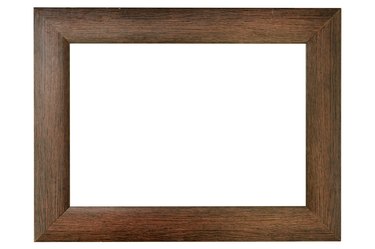
After you've completed a painting on canvas, the next step is to frame and hang your artwork -- or frame it and sell it. But one of the drawbacks of being a painter is the high cost of store-bought frames. You can eliminate that problem by making your own wood frames. You'll need: the wood, a tape measure, wood glue, wood clamps, four small L-brackets, a router, a miter box, a small handsaw and some V-shaped nails. Once you learn the process, you will never have to worry about the high cost of frames again.
The Wood
Video of the Day
Start with pine until you perfect the craft, as pine costs less than the more expensive hardwoods. Measure the dimensions of the painting to be framed. For example, if you have a 16-by-20 inch canvas, you need a one-by-two or one-by-three pine board or pine molding -- based on how wide you want the frame. If you use pine molding, you won't need to router the wood. Add twice the width of the wood to each of the four measured sides to accommodate the mitered corners; buy extra for any mistakes. For example, for a 16-by-20 canvas and a 3-inch wide board, add 6 inches to each side for a total length of 96 inches or 8 feet. An 8-foot one-by-three pine board, at the time of publication, costs less than $2.
Video of the Day
Cut the Wood
To make mitered corners, cut the wood so that it extends beyond the edges of the canvas on all sides the same width as the wood. Cut the four boards, two at 22 inches long, and two at 26 inches long. After cutting the wood, sand all the burrs, cut edges and the face of the wood with 150-grit sandpaper. At this point, you can router the flat pine boards -- unless you want a simple flat frame -- to add details to the exterior of the frame.
Mitered Corners
Set one board's end into the miter box to cut a 45-degree angle, and then miter cut the other end of the board opposite to that in a 45-degree angle. If you've done it correctly, the inner edge of the wood should fit the side of the canvas. Each of these 45-degree angles should form an imaginary line that meets in the middle of the canvas. Repeat this process for all the cut boards. Match them up so that the mitered boards form a square. Make any cutting adjustments as necessary to ensure a tight fit around the canvas. Sand the miter cuts smooth.
Frame With a Lip
If you want the canvas to sit inside the frame on a lip of wood, simply router the inside of the frame before assembling it so that it has a small ledge. Adjust the frame measurements to accommodate the width of the lip. This holds the canvas flat against the frame, not inside it. The lip also serves as a holder for cut glass to fill the frame when you want to frame watercolor pictures under glass.
Glue and Nail
Glue and nail the frame together so that its front faces down on your worktable. Use an adjustable tie wrapped and tightened around the frame or wood clamps to hold the frame tight at the corners as the glue dries. Hammer the small V-nails into the corners so that they secure both mitered corners together. After you gain more experience working with wood, you can cut slots on each of the mitered corners sides to insert a wood biscuit without having to use nails. After it dries, apply a stain and a desired finish, such as lacquer, varnish or acrylic and let dry. Set the canvas in the frame and secure it to the back of the frame with small L-brackets.